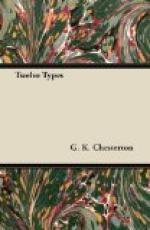It may, therefore, I think, be legitimately said that the externals of the Brontes’ life, though singularly picturesque in themselves, matter less than the externals of almost any other writers. It is interesting to know whether Jane Austen had any knowledge of the lives of the officers and women of fashion whom she introduced into her masterpieces. It is interesting to know whether Dickens had ever seen a shipwreck or been inside a workhouse. For in these authors much of the conviction is conveyed, not always by adherence to facts, but always by grasp of them. But the whole aim and purport and meaning of the work of the Brontes is that the most futile thing in the whole universe is fact. Such a story as ‘Jane Eyre’ is in itself so monstrous a fable that it ought to be excluded from a book of fairy tales. The characters do not do what they ought to do, nor what they would do, nor, it might be said, such is the insanity of the atmosphere, not even what they intend to do. The conduct of Rochester is so primevally and superhumanly caddish that Bret Harte in his admirable travesty scarcely exaggerated it. ’Then, resuming his usual manner, he threw his boots at my head and withdrew,’ does perhaps reach to something resembling caricature. The scene in which Rochester dresses up as an old gipsy has something in it which is really not to be found in any other branch of art, except in the end of the pantomime, where the Emperor turns into a pantaloon. Yet, despite this vast nightmare of illusion and morbidity and ignorance of the world, ’Jane Eyre’ is perhaps the truest book that was ever written. Its essential truth to life sometimes makes one catch one’s breath. For it is not true to manners, which are constantly false, or to facts, which are almost always false; it is true to the only existing thing which is true, emotion, the irreducible minimum, the indestructible germ. It would not matter a single straw if a Bronte story were a hundred times more moonstruck and improbable than ‘Jane Eyre,’ or a hundred times more moonstruck and improbable than ‘Wuthering Heights.’ It would not matter if George Read stood on his head, and Mrs Read rode on a dragon, if Fairfax Rochester had four eyes and St John Rivers three legs, the story would still remain the truest story in the world. The typical Bronte character is, indeed, a kind of monster. Everything in him except the essential is dislocated. His hands are on his legs and his feet on his arms, his nose is above his eyes, but his heart is in the right place.
The great and abiding truth for which the Bronte cycle of fiction stands is a certain most important truth about the enduring spirit of youth, the truth of the near kinship between terror and joy. The Bronte heroine, dingily dressed, badly educated, hampered by a humiliating inexperience, a kind of ugly innocence, is yet, by the very fact of her solitude and her gaucherie, full of the greatest delight that is possible to a




